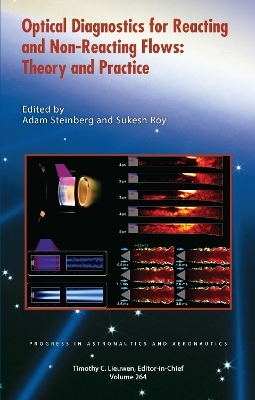
Optical Diagnostics for Reacting and Non-Reacting Flows
American Institute of Aeronautics & Astronautics (Verlag)
9781624106323 (ISBN)
Optical Diagnostics for Reacting and Non-Reacting Flows serves both as a launch pad for new students of optical diagnostics seeking a "go to" book, and as a resource for the experienced diagnostician seeking to explore new techniques, or new applications of familiar techniques. Measurement techniques that exploit lasers and light-matter interactions are uniquely capable of advancing our understanding of reacting and non-reacting flows. Such (largely) noninvasive measurement approaches may be used for visualizing and quantifying key chemical species concentrations, thermodynamic properties, and fluid-dynamic parameters. The information thus generated is essential for achieving detailed understanding of fundamental chemistry and physics. Furthermore, recent years have seen the increased use of these techniques in realistic configurations/conditions to help overcome real-world engineering challenges. Target configurations for optical measurements include canonical flames and flows, high-speed wind tunnels, combustor and component test rigs, gas-turbine engines, pulsed- and rotating-detonation engines, piston engines, and other advanced propulsion, power, and fuel systems. This contributed volume provides an extensive theoretical and practical guide to use of advanced optical measurement techniques in fluids and combustion. After a brief introduction to optical diagnostic basics, the spectroscopic and imaging topics covered are Rayleigh scattering, Raman scattering, laser-induced fluorescence, various four-wave mixing techniques, laser absorption spectroscopy, laser induced breakdown spectroscopy, molecular tagging, thermographic phosphors, particulate diagnostics, spray diagnostics, absorption spectroscopy, and chemiluminescence. Additional chapters discuss novel ways of collecting and interpreting data, namely fiber and endoscopic signal generation and acquisition, multi-dimensional imaging via tomographic reconstruction, uncertainty quantification, and data analysis.
This contributed volume provides an extensive theoretical and practical guide to use of advanced optical measurement techniques in fluids and combustion. After a brief introduction to optical diagnostic basics, the spectroscopic and imaging topics covered are Rayleigh scattering, Raman scattering, laser-induced fluorescence, various four-wave mixing techniques, laser absorption spectroscopy, laser induced breakdown spectroscopy, molecular tagging, thermographic phosphors, particulate diagnostics, spray diagnostics, absorption spectroscopy, and chemiluminescence. Additional chapters discuss novel ways of collecting and interpreting data, namely fiber and endoscopic signal generation and acquisition, multi-dimensional imaging via tomographic reconstruction, uncertainty quantification, and data analysis.
Dr. Adam Steinberg is an associate professor in the Daniel Guggenheim School of Aerospace Engineering at Georgia Tech. Prior to joining Georgia Tech, Dr. Steinberg was on the faculty of the University of Toronto Institute for Aerospace Studies and served as a research scientist at the German Aerospace Center. He obtained his PhD and MS degrees in Aerospace Engineering from the University of Michigan, and his BASc in Engineering Science from the University of Toronto. Dr. Steinberg's research focuses on overcoming the scientific and technical barriers facing future aerospace propulsion and energy conversion devices. Working closely with government and industry, his research group develops and applies advanced laser-based measurement techniques that help unravel the coupled thermal, fluid, and chemical process occurring in these devices. Topics of interest include light/matter interactions, turbulence, combustion, gas turbine engines, chemical rockets, electric propulsion, high-speed flows, data analysis, and experiment/simulation coupling. Dr. Sukesh Roy is a Senior Research Scientist and the CEO of Spectral Energies, LLC, a small business R&D company located in Dayton, Ohio. He received B.Sc. in Mechanical Engineering from Bangladesh University of Engineering and Technology (BUET), Dhaka and PhD in Mechanical Engineering from Texas A&M University at College Station, Texas. The main focus of his research is the advancement and application of lasers and laser-based sensor technologies for characterizing aerothermal flows and materials for propulsion systems. This includes: (i) ultrafast spectroscopy and imaging for temperature, velocity, and chemical species concentrations, (ii) burst-mode lasers and high-speed spectroscopy and imaging for multi-dimensional flow parameter measurements, and (iii) optical engineering to enable spectroscopy and imaging under relevant conditions for ground test facilities. Dr. Roy is a Fellow of the American Society of Mechanical Engineers and Optica (formerly the Optical Society of America), and he is an Associate Fellow of the American Institute of Aeronautics and Astronautics.
| Erscheinungsdatum | 13.02.2023 |
|---|---|
| Verlagsort | Reston |
| Sprache | englisch |
| Maße | 152 x 229 mm |
| Themenwelt | Technik ► Fahrzeugbau / Schiffbau |
| Technik ► Luft- / Raumfahrttechnik | |
| ISBN-13 | 9781624106323 / 9781624106323 |
| Zustand | Neuware |
| Informationen gemäß Produktsicherheitsverordnung (GPSR) | |
| Haben Sie eine Frage zum Produkt? |
aus dem Bereich


